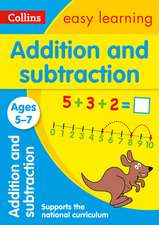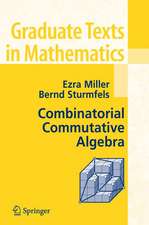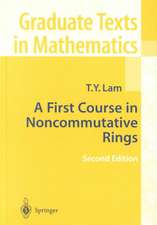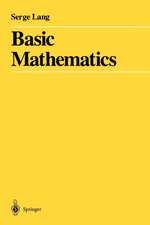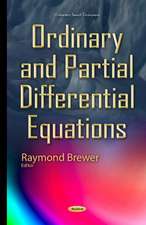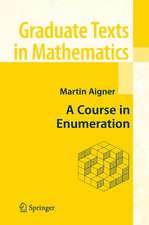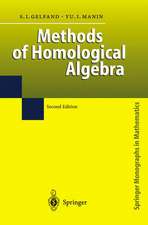Algebra: Volume I
Autor B.L. van der Waerden Traducere de F. Blum, J.R. Schulenbergen Limba Engleză Paperback – 21 oct 2003
- Saunders MacLane, Notices of the AMS
How exciting it must have been to hear Emil Artin and Emmy Noether lecture on algebra in the 1920's, when the axiomatic approach to the subject was amazing and new! Van der Waerden was there, and produced from his notes the classic textbook of the field. To Artin's clarity and Noether's originality he added his extraordinary gift for synthesis. At one time every would-be algebraist had to study this text. Even today, all who work in Algebra owe a tremendous debt to it; they learned from it by second or third hand, if not directly. It is still a first-rate (some would say, the best) source for the great range of material it contains.
- David Eisenbud, Mathematical Sciences Research Institute
Van der Waerden's book Moderne Algebra, first published in 1930, set the standard for the unified approach to algebraic structures in the twentieth century. It is a classic, still worth reading today.
- Robin Hartshorne, University of California, Berkeley
| Toate formatele și edițiile | Preț | Express |
|---|---|---|
| Paperback (2) | 453.78 lei 6-8 săpt. | |
| Springer – 21 oct 2003 | 453.78 lei 6-8 săpt. | |
| Springer – 17 oct 2003 | 454.92 lei 6-8 săpt. |
Preț: 453.78 lei
Nou
Puncte Express: 681
Preț estimativ în valută:
86.84€ • 89.71$ • 72.27£
86.84€ • 89.71$ • 72.27£
Carte tipărită la comandă
Livrare economică 25 martie-08 aprilie
Preluare comenzi: 021 569.72.76
Specificații
ISBN-13: 9780387406244
ISBN-10: 0387406247
Pagini: 265
Ilustrații: XIV, 265 p.
Dimensiuni: 155 x 235 x 13 mm
Greutate: 0.4 kg
Ediția:1st ed. 1991. 2nd printing 2003
Editura: Springer
Colecția Springer
Locul publicării:New York, NY, United States
ISBN-10: 0387406247
Pagini: 265
Ilustrații: XIV, 265 p.
Dimensiuni: 155 x 235 x 13 mm
Greutate: 0.4 kg
Ediția:1st ed. 1991. 2nd printing 2003
Editura: Springer
Colecția Springer
Locul publicării:New York, NY, United States
Public țintă
Lower undergraduateCuprins
1 Numbers and Sets.- 1.1 Sets.- 1.2 Mappings. Cardinality.- 1.3 The Number Sequence.- 1.4 Finite and Countable (Denumerable) Sets.- 1.5 Partitions.- 2 Groups.- 2.1 The Concept of a Group.- 2.2 Subgroups.- 2.3 Complexes. Cosets.- 2.4 Isomorphisms and Automorphisms.- 2.5 Homomorphisms, Normal Subgroups, and Factor Groups.- 3 Rings and Fields.- 3.1 Rings.- 3.2 Homomorphism and Isomorphism.- 3.3 The Concept of a Field of Quotients.- 3.4 Polynomial Rings.- 3.5 Ideals. Residue Class Rings.- 3.6 Divisibility. Prime Ideals.- 3.7 Euclidean Rings and Principal Ideal Rings.- 3.8 Factorization.- 4 Vector Spaces and Tensor Spaces.- 4.1 Vector Spaces.- 4.2 Dimensional Invariance.- 4.3 The Dual Vector Space.- 4.4 Linear Equations in a Skew Field.- 4.5 Linear Transformations.- 4.6 Tensors.- 4.7 Antisymmetric Multilinear Forms and Determinants.- 4.8 Tensor Products, Contraction, and Trace.- 5 Polynomials.- 5.1 Differentiation.- 5.2 The Zeros of a Polynomial.- 5.3 Interpolation Formulae.- 5.4 Factorization.- 5.5 Irreducibility Criteria.- 5.6 Factorization in a Finite Number of Steps.- 5.7 Symmetric Functions.- 5.8 The Resultant of Two Polynomials.- 5.9 The Resultant as a Symmetric Function of the Roots.- 5.10 Partial Fraction Decomposition.- 6 Theory of Fields.- 6.1 Subfields. Prime Fields.- 6.2 Adjunction.- 6.3 Simple Field Extensions.- 6.4 Finite Field Extensions.- 6.5 Algebraic Field Extensions.- 6.6 Roots of Unity.- 6.7 Galois Fields (Finite Commutative Fields).- 6.8 Separable and Inseparable Extensions.- 6.9 Perfect and Imperfect Fields.- 6.10 Simplicity of Algebraic Extensions. Theorem on the Primitive Element.- 6.11 Norms and Traces.- 7 Continuation of Group Theory.- 7.1 Groups with Operators.- 7.2 Operator Isomorphisms and Operator Homomorphisms.- 7.1 The Two Laws of Isomorphism.- 7.4 Normal Series and Composition Series.- 7.5 Groups of Order pn.- 7.6 Direct Products.- 7.7 Group Characters.- 7.8 Simplicity of the Alternating Group.- 7.9 Transitivity and Primitivity.- 8 The Galois Theory.- 8.1 The Galois Group.- 8.2 The Fundamental Theorem of the Galois Theory.- 8.3 Conjugate Groups, Conjugate Fields, and Elements.- 8.4 Cyclotomic Fields.- 8.5 Cyclic Fields and Pure Equations.- 8.6 Solution of Equations by Radicals.- 8.7 The General Equation of Degree n.- 8.8 Equations of the Second, Third, and Fourth Degrees.- 8.9 Constructions with Ruler and Compass.- 8.10 Calculation of the Galois Group. Equations with a Symmetric Group.- 8.11 Normal Bases.- 9 Ordering and Well Ordering of Sets.- 9.1 Ordered Sets.- 9.2 The Axiom of Choice and Zorn’s Lemma.- 9.3 The Well-Ordering Theorem.- 9.4 Transfinite Induction.- 10 Infinite Field Extensions.- 10.1 Algebraically Closed Fields.- 10.2 Simple Transcendental Extensions.- 10.3 Algebraic Dependence and Independence.- 10.4 The Degree of Transcendency.- 10.5 Differentiation of Algebraic Functions.- 11 Real Fields.- 11.1 Ordered Fields.- 11.2 Definition of the Real Numbers.- 11.3 Zeros of Real Functions.- 11.4 The Field of Complex Numbers.- 11.5 Algebraic Theory of Real Fields.- 11.6 Existence Theorems for Formally Real Fields.- 11.7 Sums of Squares.
Recenzii
From the reviews:
"The book … is a reprinted version of the original English translation of the first volume of B. L. van der Waerden’s ‘Algebra’, without any alterations. However, it is the first softcover printing, worth the price and particularly handy. It is very gratifying to have such an edition … so that further generations of students can both afford it and use it as still one of the best sources … . is one of the most influential textbooks in mathematics of the 20th century." (Werner Kleinert, Zentralblatt MATH, Vol. 1032 (7), 2004)
"In the glad to have you back department, I’m delighted that Springer has decided to reprint the two volumes of B.L.van der Waerden’s Algebra. Based in part on lectures by Emmy Noether and Emil Artin, this is the book that brought ‘abstract algebra’ to the mathematical world. … the book reflects the excitement that accompanied the birth of axiomatic algebra. … a book to treasure. I am glad it’s back." (MAA-Online, March, 2004)
"The book … is a reprinted version of the original English translation of the first volume of B. L. van der Waerden’s ‘Algebra’, without any alterations. However, it is the first softcover printing, worth the price and particularly handy. It is very gratifying to have such an edition … so that further generations of students can both afford it and use it as still one of the best sources … . is one of the most influential textbooks in mathematics of the 20th century." (Werner Kleinert, Zentralblatt MATH, Vol. 1032 (7), 2004)
"In the glad to have you back department, I’m delighted that Springer has decided to reprint the two volumes of B.L.van der Waerden’s Algebra. Based in part on lectures by Emmy Noether and Emil Artin, this is the book that brought ‘abstract algebra’ to the mathematical world. … the book reflects the excitement that accompanied the birth of axiomatic algebra. … a book to treasure. I am glad it’s back." (MAA-Online, March, 2004)
Textul de pe ultima copertă
...This beautiful and eloquent text served to transform the graduate teaching of algebra, not only in Germany, but elsewhere in Europe and the United States. It formulated clearly and succinctly the conceptual and structural insights which Noether had expressed so forcefully. This was combined with the elegance and understanding with which Artin had lectured...Its simple but austere style set the pattern for mathematical texts in other subjects, from Banach spaces to topological group theory...It is, in my view, the most influential text in algebra of the twentieth century.
- Saunders MacLane, Notices of the AMS
How exciting it must have been to hear Emil Artin and Emmy Noether lecture on algebra in the 1920's, when the axiomatic approach to the subject was amazing and new! Van der Waerden was there, and produced from his notes the classic textbook of the field. To Artin's clarity and Noether's originality he added his extraordinary gift for synthesis. At one time every would-be algebraist had to study this text. Even today, all who work in Algebra owe a tremendous debt to it; they learned from it by second or third hand, if not directly. It is still a first-rate (some would say, the best) source for the great range of material it contains.
- David Eisenbud, Mathematical Sciences Research Institute
Van der Waerden's book Moderne Algebra, first published in 1930, set the standard for the unified approach to algebraic structures in the twentieth century. It is a classic, still worth reading today.
- Robin Hartshorne, University of California, Berkeley
- Saunders MacLane, Notices of the AMS
How exciting it must have been to hear Emil Artin and Emmy Noether lecture on algebra in the 1920's, when the axiomatic approach to the subject was amazing and new! Van der Waerden was there, and produced from his notes the classic textbook of the field. To Artin's clarity and Noether's originality he added his extraordinary gift for synthesis. At one time every would-be algebraist had to study this text. Even today, all who work in Algebra owe a tremendous debt to it; they learned from it by second or third hand, if not directly. It is still a first-rate (some would say, the best) source for the great range of material it contains.
- David Eisenbud, Mathematical Sciences Research Institute
Van der Waerden's book Moderne Algebra, first published in 1930, set the standard for the unified approach to algebraic structures in the twentieth century. It is a classic, still worth reading today.
- Robin Hartshorne, University of California, Berkeley


